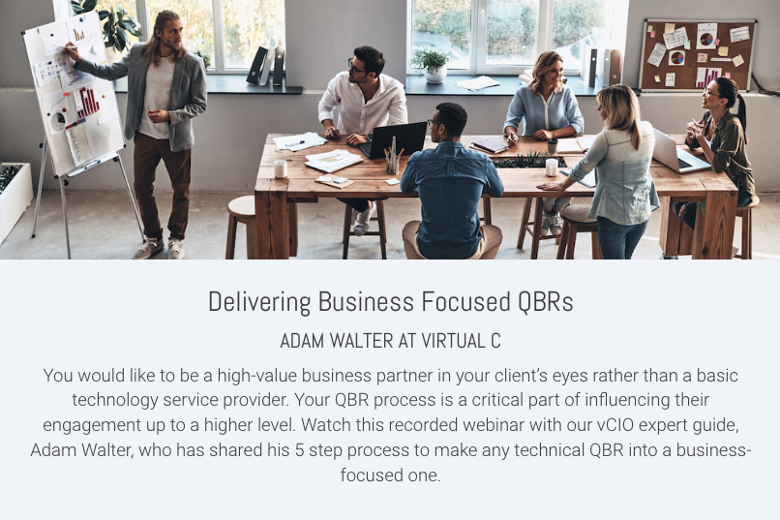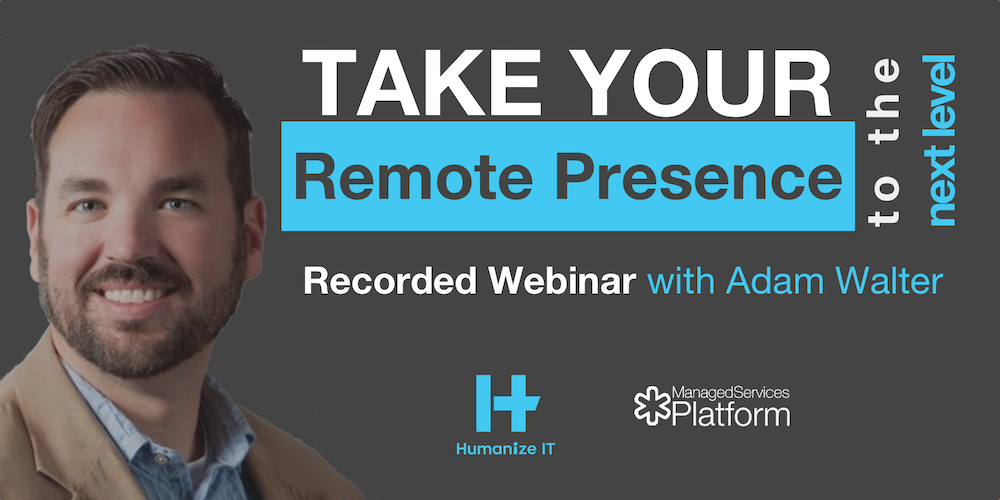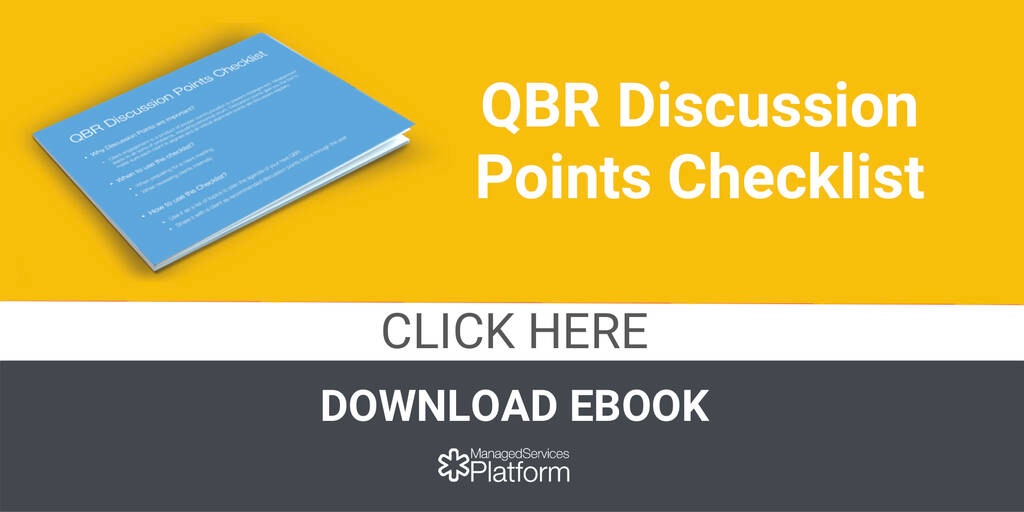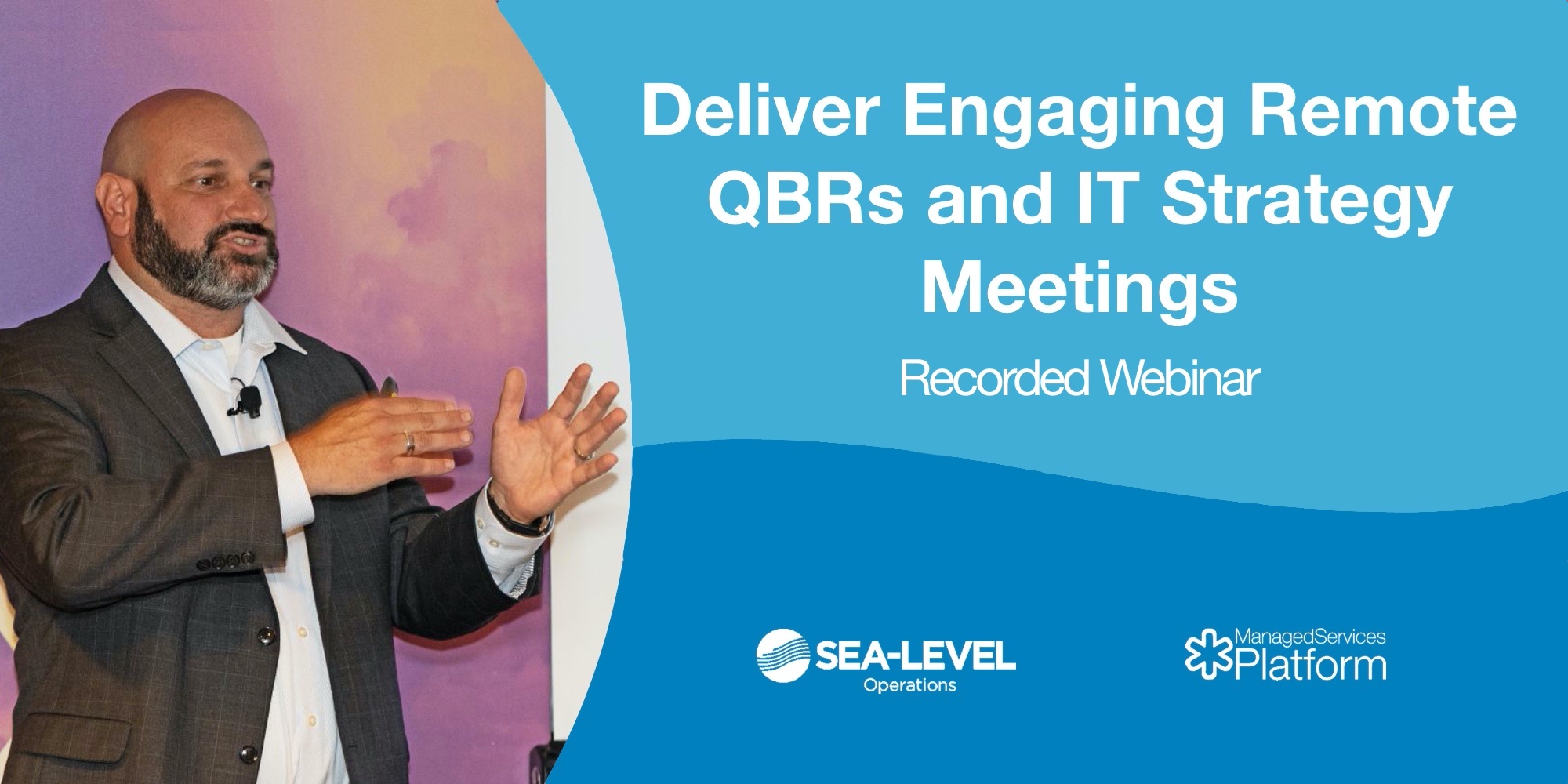Why your QBRs are costing you, customers
By Adam Walter on September 2 2019
-2.jpg)
For those of us who have been in technology for a while, we have seen some pretty crazy setups from well-meaning people. Largely this is because we have very smart capable people trying to work in environments with limited knowledge. Most were trying their hardest but just didn’t know any better.
Some of the crazy things I saw back in the day were “vlans” that were actually just subnets, firewalls with giant holes in the ruleset, and unrestricted VPNs that were completely insecure. These mistakes were not made by lazy admins, they were made by well-intentioned technicians that didn’t know they were doing anything wrong. All they knew was that things were working smoothly.
But how do we know when we are doing something incorrectly?
This is how it works in the technical industry, new items come out so often that we do our best to learn what we can. Most of us will reach out when something isn't working. Google is always there. We can also hire a consultant who specializes to review our work and can show us the ropes. But how do we know when we are doing something incorrectly? After all ‘Any-Any’ firewall rules will get the job done right?
The same problem exists within vCIO programs and QBR delivery. How would you know if you are doing them wrong? Are you assuming things are going well just because your client is present and getting details? If this is the case then it is very much like putting an Any-Any firewall rule in place. Sure it will work, but what happens when your client experiences the right way?
There is definitely a ‘right’ way to deliver a vCIO program and definitely a ‘right’ way to deliver business-focused QBRs. We have many stories of MSPs who lose customers when the customer sees a better way and realizes what they have been missing.
The best way I can think to help you identify whether or not you are running quality QBRs is to compare and contrast a tactical vs a business-focused QBR. Tactical QBRs are very useful when talking to technical professionals, business QBRs are best suited for talking to...yes you guessed it...business professionals. Let's take a look at a QBR delivery by a vCIO. The first situation will focus on a tactical delivery and the other will focus on the business.
Tactical QBR:
MSP R Us comes in to deliver a review of their activities for the quarter. They do a fantastic job of showing the customer how many tickets were processed and give them progress reports on the firewall upgrade. There is even a review of the new features the firewall offers. The customer is happy with the progress on the upgrade and they can see that tickets are being handled in an appropriate amount of time.
Business-focused QBR
MSP R Us comes in to deliver their review of activities for the quarter. However, they do not talk about tickets or the firewall upgrade. Instead, they talk through how the business is doing and review major business objectives from the previous quarter. It is brought up that last quarter the training team was having issues sharing videos with clients and hosting webcasts so a firewall project was started to stabilize the connection. The conversation centers around how things are going with the training team and if they are meeting their goals now. It turns out the upgrade has helped significantly.
They have noticed though that while the streaming has stabilized, they are not getting high resolution and would like to know if someone could help them out. The vCIO notes the request for the coming quarter as a project and will open a ticket.
The conversation continues with any other areas of business that need to be addressed in the next quarter. The client states that they have an big product release coming up and are feeling anxious. The vCIO also notes this and creates a change freeze during that time to ensure that disruptions to workflow are minimal.
Review
In either situation, nothing was done “wrong” persay but you can see the business-focused QBR was much more fluid and quite a bit more information was gathered about how to help the client.
Most MSPs will run tactical QBRs because it is familiar and sticks to their wheelhouse. However, they are missing out on a big piece of customer experience. They are also missing out on valuable insights as to upcoming projects and whether or not project delivery is meeting business goals.
The question is, how do you get your QBRs to be less tactical and more business-focused? The good news is, with focus and hard work you can build this. The bad news is that just like learning appropriate firewall design it is a bit of a process. You need a few pieces:
- An annual framework for delivery where you have created a relationship with your client.
- A continuous feedback loop for business objectives.
- Give your staff the confidence to lead non-technical conversations.
You can create this process with hard work, or you can also hire a consulting/coaching agency to come in and develop the process and employees.
The one thing we know is that if you do not start delivering business-focused QBRs someone else will. So the real question you need to ask is:
Do you want to be the MSP clients switch FROM,
or do you want to be the MSP clients switch TO?
Systematic service development process
By Denes Purnhauser on February 17 2017
One of the hot topics in the bootcamp was a typical MSP issue - managing client agreements. The problem gets verbalized in different ways: "I have many new services I would like to sell to existing clients" or "I have to re-onboard all of our customers because the agreement is very old" or "I want to increase our prices to reflect the improvements and additional tools we introduced" or "I barely make any money and I need to renegotiate our prices". Sound familiar? We’d like to introduce a systematic approach to solve this problem for now and the future.
What is the real underlying problem
The original problem is nothing more complex than the ad-hoc and un-managed service development process period. As a service company you spend a whole lot of time developing your services. All internal processes are service development, all tool deployments are service development, all new vendors are service development...meaning everything you do that isn’t providing a service to a client is you developing your services. If you do that without any control mechanisms the result will be misalignment with clients.
We all know that service development doesn’t happen without reason. The technology is always changing, the market needs new services, old services become obsolete, clients come and go, and new opportunities arise. As a managed service provider, a plethora of moving parts to deal with can result in less profitability, under-utilized services and obsolete agreements. The usual solution is to spend more facetime with clients and explain, negotiate, present, and discuss with the owners or account management team why you need to re-align. Sometimes, however, we need to manipulate prices, introduce new services or otherwise change the set agreements.
Solving these symptoms requires identifying the root problem: make the service development, deployment and communication a conscious effort.
Differentiate yourself from your competition and
become sales ready in 30 days
Service Development and Deployment Process
Without going deep into details, let's go through the process quickly. It’s surprisingly simpler than we’ve found most people fear. This is because of the closely related industry with which we face this challenge: software companies. We don’t have to do much more than understand how they’re solving this problem, and apply the practices.
- Roadmap: Software developers have an internal bible called The Roadmap. This document lists out all the changes they have to make in their tool - new features, updates, fixes, internal processes, and everything else. That roadmap is a central element of their efforts, and the majority of their team is guided by that document.
- Agile development: the gist of being agile is not to execute long term plans, but get the most important items from the roadmap and ship a version of them early. That helps get to the endpoint step by step, while giving the customers tangible value along the way. It also helps focus the development effort with (typically) understaffed teams.
- Beta: Sometimes developers will ask you to participate in beta programs, where you get access to improved features faster (and take on the risk of reliability), and they can test out the user experience and further develop the product, validate their ideas, fine tune processes and the optimize the user experience.
- Release: As a software user, and even more so, a cloud application user, you know that applications are changing all the time...not minute by minute while you’re using them, but by release cycles. The development team develops new features, new modules, enhance the UI, etc, and you get it as a package in the new release.
- Upgrade: Sometimes it turns out that the function you just started to use is going to be an add-on or in a higher-priced tier. You still can use the product in the beta period, but you might have a decision to make whether you want to upgrade to enjoy the new features.
To summarize:
- They have a conscious effort to develop their products and services
- There is a guiding document for everyone to be in focus
- There is a mechanism (releases) to deploy and communicate changes with customers
- There is a mechanism (beta) to engage users with the new experience
- There is a mechanism to redefine the offering, giving the customer the option to stay on the current plan or upgrade
So let's put these basic principles into play as an MSP
- Roadmap: as an MSP you need to have a guiding document listing out all the changes you want to make with your services. Internal process fixes, new tools, new processes, new services - everything related to your services. As you plan your development activities the roadmap helps your team to stay flexible while keeping priorities clear.
- Agile development: based on your roadmap you pick the most important developments, selecting what matters most, instead of scrambling to deal with everything on the board. Every week you can have a development meeting and focus your efforts on specific internal processes, your customer interfacing or implementing certain features of vendor applications. That gives your team focus and a sense of accomplishment as opposed to the futility of firefighting on internal projects.
- Beta: you might pick specific clients to enjoy the benefits of new services. You can introduce vCIO, Technical Account Management, Application management or even security services to your clients as a beta program. The process helps you to get their consent of the experiment (and also lets them know development is progressing) and you can offer these new services or updated experiences for free for a while.
- Release: the main thing to consider in release cycles is to minimize internal stress and enhance communication. You can batch many items together and send a quarterly email, letter or a complete webinar to let all clients know about changes being made, and how they affect them. If you provide Account Management, the Quarterly Business Review (QBRs) are perfectly suited to presenting innovations to customers.
- Upgrade: let's assume you made four quarterly updates on your services during the year. You communicated well what’s beta, what’s sustainable fixes, upgrades (which will be part of their current plan) and what are going to be new service line items (extra charge). Typically once a year you can repackage your offering to include all new services to the current packages and also display the add-ons and features they can access if they upgrade. This method of repackaging means only those clients will enjoy the new features and benefits who upgrade. This will be their decision.
Benefits
- proactive process gives you control over your services to make sure clients are seeing the value of your developments and progress
- the roadmap can give you peace of mind, clarifying where to develop, and helping allocate the necessary resources to streamline development
- agile development gives the team clarity - a process for working on your company instead of for your company - crucial to your ability to scale
- the beta can help you develop services with clients without incurring the pitfalls of nascent services
- releases help you communicate changes very effectively without creating confusion
- upgrades help you restate your value proposition every year, set expectations and give your clients a sense of progress and choice
Five principles behind an engaging Quarterly Business Review process
By Denes Purnhauser on January 12 2017
In our design of the new Quarterly Business Review tool we wanted to ensure that MSPs can find business opportunities with existing clients, enhance the quality of their engagement, become a business partner and demonstrate the value they provide all at once. Achieving those multiple goals in the midst of commoditization of traditional infrastructure management services requires finding a balance among five different strategies. Let's check those success factors to make sure you deliver timely and engaging QBRs.
UPSELL YOUR CLIENTS WITH STRATEGIC QBRS AND IT STRATEGY MEETINGS
We’ve identified several common mistakes managed services providers are making during the QBR
process, leading to less and lower quality client engagement, over complicated processes and too much work. We wanted to create a tool that’s straightforward, easy to use, and guides the service provider to optimal client engagement.
1. 360 Degree view of IT
Most MSPs’ QBR is all about the explanation of their services, performance and ‘speeds and feeds’ of the infrastructure, and the motivation is to show they work hard for the money. This is hardly engaging.
Being engaging of course requires the ability to ask questions from the client’s leadership regarding their business priorities, problems they’re facing or opportunities they see or think they could find. It gives you the chance to put your services in their business context. You also need to be able to ask questions of front-line people - struggles they have with applications, processes or any user-related opportunity. This all gives the service provider the ingress to solve real problems and start scoping projects you can deliver. If you can’t focus on 360 degrees of their business with technology, you can’t have a sustainable client engagement process, so we designed the tool to gather variegated input from several distinct sources in preparation for the QBR, where you’ll have a more comprehensive, holistic view through the meeting.
2. Balance the business and technology
MSPs are often the victims of their own aptitude. When they start working with a client, that client is usually dealing with a suite of frustrations and confusion...nothing seems to be working. We can’t let them set the conversation in this miserable frame. It has to elevate from the technology issues to finding solutions to business problems in order to deliver visible business value.
It’s always a good idea to keep your target audience entertained, and for us that’s the various opportunities they can leverage with their technology. When you stay relevant you’ll generate visible value persistently. To this end we designed a specific thought-provoking mini questionnaire for the leadership team that you can run prior to the meeting, giving you the opportunity to understand their business related issues, problems and goals. Once they feel understood, your suggestions and advice will be more on target, more easily adopted and more valued by your customer. Just focus on their goals rather than your agenda and you’ll sell them new projects.
3. Nurture maturity
Many MSP client has just started their journey with you and many are your clients for years. Many client of yours have pretty big complex business models many of them has very small and simple operations. That diversity creates a wide range of IT maturity which need to be managed.
Our philosophy is this maturity needs to be nurtured all the time. If your client has a super low maturity you need a tool not to overwhelm them, however if they have a pretty mature IT you still should nurture it further. We designed the QBR tool to be modular. If there is a super small client you do not cover everything. You might just focus on the IT metrics first then quarter by quarter introduce new aspects such as the business goals or applications. However, if their maturity is high enough you can involve more people to the conversation, focus on different line of business applications or offer additional vCIO services with more IT strategy and execution.
4. Cadence of Accountability
Many MSPs do Quarterly Business Reviews once or twice a year, either because they cannot allocate the time or believe there’s no need for quarterly interactions. There is no real cadence to communication, just occasional meetings.
We believe that having a strict quarterly rhythm of the process is crucial. We even designed the report in a way that incentives regular completion - it feels awkward if a Quarter is missing. We wanted to make sure the process becomes an easy routine for the team, not a one-off. Some items in the QBR report relate to only the current quarter, while others display their progress across them. For example the latter shows the trend of fixing business problems better than just a snapshot of current issues, while for technical details we need to work on current issues with a narrower focus.
5. The right level of details
One popular strategy among managed services providers is creating standards to which all clients must comply. While this is a great initiative to simplify processes, it can create too much work and misalignment with clients at the same time.
We’ve designed service standards with enough flexibility for you to evaluate and implement alongside your processes and best practices, to increase your efficiency. It doesn’t make sense to create detailed standards nobody feels are relevant, or have the time to follow. We let you define standards for each infrastructure or application category so you aren’t bombarding clients with detailed standards they don’t even comprehend. We give you a 1-100 scale to evaluate their performance against a standard, so you can best approach the balance of compliance and effectiveness. For example one level of performance can get a lower score for a more mature or bigger organization than a small simple one. Maybe focusing on that area doesn’t deliver tangible value to a small organization, but for a mature corporation it’s a necessity. You’re able to stay relevant to your clients while implementing your skillfully crafted standards that deliver value to them and you.
Conclusion
Implementing a professional, relevant and engaging Quarterly Business Review process is a must theses days. The success of this process can literally make or break your relationship with your clients. Let's learn from other MSPs and improve your chances to stay relevant to clients in years to come!
Leveraging the IT Quarterly Business Reviews
By Denes Purnhauser on August 21 2015
Many IT managed services providers are doing some type of Quarterly Business Reviews (QBR) and most have trouble delivering it with the right cadence and voice. It’s too technical and fails to shows business value to the executive team. Introducing QBRs poorly can backfire and land the MSP into a more technical role. Let's take a look at some cool techniques to engage clients with Quarterly Business Reviews.
Upsell your clients with strategic QBRs and IT strategy meetings
Hint #1 - Talk business
Challenge: Whereas it is not a significant challenge to talk business with most owners as they are fluent with marketing, can connect the dots with typical business process issues and understand the overall pains of the client, this is not the case with tech people.
Solution: We cannot give every account manager an MBA but we can help them to ask the right questions. Questions make magic happen in this process, especially if they discover a problem related to the customer’s business. We have put together Executive QBR Power Questions that discuss relevant business issues during the meeting. Asking the right questions can engage the client and allow you to offer technical solutions for most business problems.
Hint #2 - Find out some bottlenecks
Challenge: We all know clients who could do with a better document management system, better task management or a better general management system for the company. The trick is to qualify them quickly and get them on the same page during the QBR.
Solution: Graders can be used to qualify clients for a defined IT solution. For example, we can ask seven relevant questions with possible Yes/No options about their general productivity. The seven questions lead to 7 solutions/best practices/features and so on. Where they have low scores a ready productivity application can help solve their issues. This helps start a business conversation based on real needs. Graders about security, document management, SaaS applications are a great way to introduce this conversation.
Hint #3 - Proactive Development
Challenge: If we keep checking the warranties, antivirus subscription, bomb reports, risks and hardware replacements during the QBRs, it can become a boring technical conversation. We’d rather show them we would like to proactively develop their business and elevate their maturity.
Solution: Proactive Customer Development is an expression we use to truly assess where they are and the needed next steps in becoming more competitive with IT. It can be to implement IT Budgets, to better manage their vendors, to invest in an IT strategy workshop or just focus on NIST cyber security. We can pre-package 10-15 QuickWin IT management projects and typically sell these easy to fix low hanging fruit items. It can be a Disaster Recovery Plan, a Mobile Security Project or training the staff in going online securely. We use a questionnaire to measure many different elements, to learn what’s missing and to offer prepackaged projects.
Hint #4 - Internal Compliance
Challenge: If we do not set some goals or achieve mutual vision with the clients, it will be hard to be on the same page down the road. Setting the stage for what we mean about being competitive with IT is important. Without that, we are missing the business context of our services. It can lead to conversations of costs instead of investments.
Solution: The QBR is a questionnaire and report determining the IT benchmark by which we measure the progress for our clients. It sets standards and constraints of internal compliance with which we suggest to them. The questions are business rather than technology related, designed to understand the ‘what and why’ needed to be in place to be competitive with IT. Why does it matter to have an IT strategy? Why does it make sense to manage the vendors and check the budget? Why does it make sense to manage every device from a security point of view? It helps you to use the QBR to set goals and deliverables for the next quarter, and then track progress. This exercise can generate many opportunities with your clients.
Conclusion:
There are many ways to make the QBR better by being more client focused. The tools you’ve seen here are integral Managed Services Platform methods, and just a sample of the opportunities.
Business focus need not be so complicated...we have the tools needed to make it easy and engaging for both you and your clients.
Proactive Customer Development: Leverage your QBRs
By Denes Purnhauser on May 5 2015
 Most IT managed services providers are quite proud of how proactive they are, especially in terms of technical services like maintenance, antivirus, warranty, etc. However, if we look at their client's IT savvy, operational maturity, and IT enablement, this is less true. Here are four easy tips to leverage Quarterly Business Reviews and implement the proactive mindset on a higher level.
Most IT managed services providers are quite proud of how proactive they are, especially in terms of technical services like maintenance, antivirus, warranty, etc. However, if we look at their client's IT savvy, operational maturity, and IT enablement, this is less true. Here are four easy tips to leverage Quarterly Business Reviews and implement the proactive mindset on a higher level.
If you do Quarterly Business Reviews (QBRs), you can start working on these items immediately. If you’re not familiar with the term, just imagine you’re sitting down with your clients regularly for an informative and engaging business meeting.
1. Preparation for the QBRs
Skip the infrastructure based preparation for now. Let's concentrate on their business instead. Check their industry, and consult with a couple of people...try to understand their pressing needs right now. It can be sales, marketing, cash flow, internal processes, anything that is not IT. For an easy introduction to this conversation let's use the business conversation tool from our free MSP 2.0 Quickstarter Kit.
Here’s an example: check their LinkedIn profile. Is everybody from the sales department using LinkedIn? How many connections do they have? There’s a chance they are not big on business social media. Let's download some intelligence about LinkedIn and social selling and put together a 5 minute session for the QBR.
Let’s add more: look for Slack as an online collaboration hype. Sidekick is a nice sales automation tool out there. Check out Do.com for managing better meetings. Let's put those items on the agenda as HOT products... see what they think and have a conversation.
Sooner or later they are going to read about these software somewhere. If they get important IT based information from somewhere else, our position is redundant. We have to be the center of relevant knowledge on business IT.
2. Implement a killer agenda
Prepare a real agenda. Send it before the meeting, leave room for curiosity, and plan for it to be 60-90 minutes. Use do.com and demonstrate a well-organized meeting with a kick-ass tool. Put business issues into the agenda like "Suggested solutions for pressing needs: sales, marketing, cash flow." Include items to ensure we do not just talk, but act: "Clarifying the deliverables for the next Quarterly Plan," or "Review of IT Productivity Initiative."
It may even sometimes sound trivial, but you need to present it with a proactive mindset. We do not want them to have to ask us about training their users, or what is hot out there. We have to act before they find out about so many opportunities they could leverage from somebody else. We need to be the fountain of great information. Keep in mind you can use this one agenda, with custom modifications, for every client for the given quarter.
3. Forget Bomb reports
Bomb reports and infrastructure reports are fading into the past. Now we are on top of the game, and they should not have any critical issue with support. It can be mentioned in passing that every possible gauge is green and not to worry. They are paying us to keep them green. Don’t forget that customer behavior, motivation and problem awareness has changed dramatically. There are still of course companies out there without decent infrastructure. For them the traditional IT reports are a must, educating them and setting expectations. But sooner or later we solve those problems so we have to move forward. If their IT maturity grows, we have to adjust our reports as well.
There is a better way to use business type gauges: Graders, and Opportunity Sheets. These tools put together checklists on clients’ use of best practices, processes, and so on. We just check whether they are being used, and we can come to a conclusion whether they are working effectively.
For example, we check for productivity and ask about emails, best practices, file sharing, searching for documents, version control, etc. In just a few minutes they have a grade on a scale from 1-5. If they are missing three points then we let them know we should have a talk. Believe me, they’ll be much more interested in that than in expiring warranties and quotes for the replacement of devices that are working fine.
4. Campaigns to release peer pressure
Prepare for a campaign every quarter and your MSP sales and development goals can skyrocket. Imagine this: June is the month of security. We do benchmarks sets for every client who signs up as well as teach best practices, prevention for users, basic safety guidelines, and do a Disaster Recovery Plan with 30% discount.
The idea is to make sure everybody is on board. It’s easier to make it a campaign and do 10 DRPs with a discounted rate rather than selling individually. Also, it is easier to communicate the campaign through emails, and brochures.
Every month or every quarter, you need some unique flavor to show them your skills.
If you are a pro, you can create batched events for that. For example, classroom training, seminars for managers, users among your clients, launch-and-learn sessions for executives. Let's lead the community. When people see their peers working on the same things, they can feel more urgency to take action, and are often more actively involved in solving the problems rather than just discussing them..
Conclusion:
Change the conversation: be proactive about their business, not just their IT infrastructure. Let's move and shake them every quarter and create a community of IT savvy executives who you can lead to progress. If you do, your client base will give you the necessary growth without extraordinary new customer acquisitions, and your referral engine will fire all cylinders!






